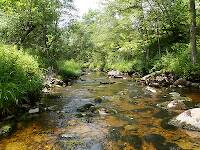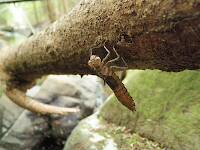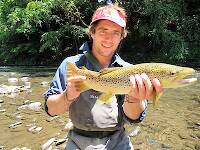
Salmonflies
Pteronarcys californica
The giant Salmonflies of the Western mountains are legendary for their proclivity to elicit consistent dry-fly action and ferocious strikes.
Featured on the forum

Troutnut is a project started in 2003 by salmonid ecologist Jason "Troutnut" Neuswanger to help anglers and
fly tyers unabashedly embrace the entomological side of the sport. Learn more about Troutnut or
support the project for an enhanced experience here.
Quillgordon on May 8, 2007May 8th, 2007, 12:02 pm EDT
I found two large stone nymphs today, which surprised me for this stream.
One was mostly black with some yellow markings..... probably a 'yellow sallie'......... Ok.
The other....... was completely yellow/white, no other markings anywhere. I was totaly shocked to see either, but this one totally shocked me. This one was a little larger and broaded than the first.
Both were at least an inch long.
I did not remove them from the stream, they just crawled around the rock to hide.
I don't see anything on this site that looks like the latter nymph. Of course i have no camera..........yet!
Anyone have any ideas??????
One was mostly black with some yellow markings..... probably a 'yellow sallie'......... Ok.
The other....... was completely yellow/white, no other markings anywhere. I was totaly shocked to see either, but this one totally shocked me. This one was a little larger and broaded than the first.
Both were at least an inch long.
I did not remove them from the stream, they just crawled around the rock to hide.
I don't see anything on this site that looks like the latter nymph. Of course i have no camera..........yet!
Anyone have any ideas??????
Flyfishing is a state of mind! .............. Q.g.
C/R........barbless
C/R........barbless
Quillgordon on May 8, 2007May 8th, 2007, 12:30 pm EDT
DMM,
When they molt, don't they stay the same color ?
When they molt, don't they stay the same color ?
Flyfishing is a state of mind! .............. Q.g.
C/R........barbless
C/R........barbless
Troutnut on May 8, 2007May 8th, 2007, 3:11 pm EDT
Generally they don't. Their normal color returns pretty quickly (I don't know the number but probably anywhere between an hour and a day) but immediately after molting many species are very pale, even nearly white.
Jason Neuswanger, Ph.D.
Troutnut and salmonid ecologist
Troutnut and salmonid ecologist
Quillgordon on May 9, 2007May 9th, 2007, 1:49 am EDT
OK............ I learned something new!
Thanks Guys!
* I saw tan caddis hatching all day, but only saw 1 fish rise.
I wonder why?
Cheers!
Thanks Guys!
* I saw tan caddis hatching all day, but only saw 1 fish rise.
I wonder why?
Cheers!
Flyfishing is a state of mind! .............. Q.g.
C/R........barbless
C/R........barbless
GONZO on May 13, 2007May 13th, 2007, 3:29 pm EDT
John,
Congratulations on discovering your first "molt." When insects shed their "skin" at the end of each instar, most are nearly colorless (often white or pale yellow), soft, and helpless. The thing to remember from a fly-fishing standpoint is that fish are quick to gobble these vulnerable freshly molted insects whenever they can find them. Although it is anyone's guess as to how many molts find their way into the drift, those that do cannot hide, and the whitish color signals vulnerability to the trout. A white stonefly nymph or a white or pale yellow mayfly nymph can be a very attractive searching fly at times.
At about an inch long, the stoneflies you found wouldn't be "yellow sallies," but (most likely) one of the Perlidae. Both "yellow sally" and "golden stone" are very loosely applied terms, but the former usually refers to Perlodidae species (although some Chloroperlidae and some small Perlidae--like Perlesta--are sometimes called yellow sallies locally). Golden stone is the term often applied to some of the larger, black-and-yellow Perlidae, like Paragnetina immarginata, Agnetina capitata, or some of the more colorful Acroneuria species.
Are you sure that they were actually hatching? I only ask because fly fishers are constantly fooled by believing that large numbers of adult caddisflies in the air indicate that a hatch is underway. Usually this is a mating flight of males and is of little interest to most fish. It does indicate that females should be laying eggs at some later time, but the actual emergence may have occurred much earlier--even as much as a week or so before. (Caddisflies often live quite a bit longer in their adult stage than mayflies do.)
One way to keep from being fooled by the mating flights is to observe the behavior of the caddisflies. If most of them are beating a steady flight upstream or are dancing in clusters over the water, it's a sure bet that a mating flight is in progress. Most caddisflies fly quickly to streamside cover when they emerge, so far fewer flies are in the air during a typical emergence than during a typical mating flight (and those that crawl out to emerge are rarely seen in the air during emergence). Only really heavy emergences put many adults into the air, and then most are flying directly to cover. I hope that might explain the situation you describe. (It's even quite possible that the one rise you saw was not to a caddisfly.)
Congratulations on discovering your first "molt." When insects shed their "skin" at the end of each instar, most are nearly colorless (often white or pale yellow), soft, and helpless. The thing to remember from a fly-fishing standpoint is that fish are quick to gobble these vulnerable freshly molted insects whenever they can find them. Although it is anyone's guess as to how many molts find their way into the drift, those that do cannot hide, and the whitish color signals vulnerability to the trout. A white stonefly nymph or a white or pale yellow mayfly nymph can be a very attractive searching fly at times.
At about an inch long, the stoneflies you found wouldn't be "yellow sallies," but (most likely) one of the Perlidae. Both "yellow sally" and "golden stone" are very loosely applied terms, but the former usually refers to Perlodidae species (although some Chloroperlidae and some small Perlidae--like Perlesta--are sometimes called yellow sallies locally). Golden stone is the term often applied to some of the larger, black-and-yellow Perlidae, like Paragnetina immarginata, Agnetina capitata, or some of the more colorful Acroneuria species.
I saw tan caddis hatching all day, but only saw 1 fish rise. I wonder why?
Are you sure that they were actually hatching? I only ask because fly fishers are constantly fooled by believing that large numbers of adult caddisflies in the air indicate that a hatch is underway. Usually this is a mating flight of males and is of little interest to most fish. It does indicate that females should be laying eggs at some later time, but the actual emergence may have occurred much earlier--even as much as a week or so before. (Caddisflies often live quite a bit longer in their adult stage than mayflies do.)
One way to keep from being fooled by the mating flights is to observe the behavior of the caddisflies. If most of them are beating a steady flight upstream or are dancing in clusters over the water, it's a sure bet that a mating flight is in progress. Most caddisflies fly quickly to streamside cover when they emerge, so far fewer flies are in the air during a typical emergence than during a typical mating flight (and those that crawl out to emerge are rarely seen in the air during emergence). Only really heavy emergences put many adults into the air, and then most are flying directly to cover. I hope that might explain the situation you describe. (It's even quite possible that the one rise you saw was not to a caddisfly.)
Quillgordon on May 14, 2007May 14th, 2007, 12:00 am EDT
Gonzo,
OK..... I didn't know we had any large 'stones' here, so I was surprised to see them! I would say they are safe, because they were in very shallow water near the shoreline. I know we have the little black/brown stones earlier in the year.
Caddis...
Yes they were definately hatching( coming out of the water). They came out of the water and headed for the trees. There were no clouds of caddis over the water; I didn't mean to imply that.
I caught two of them. They were about a size 16, tan/green body and dark speckled wings. There were also a few larger caddis; they looked similar to these, but I couldn't capture any.
My first record of a good caddis hatch was on 5/8/07, which is late. I mentioned earlier that I was worried about the water level variations and its effect on the insect hatches.
John...
OK..... I didn't know we had any large 'stones' here, so I was surprised to see them! I would say they are safe, because they were in very shallow water near the shoreline. I know we have the little black/brown stones earlier in the year.
Caddis...
Are you sure that they were actually hatching? I only ask because fly fishers are constantly fooled by believing that large numbers of adult caddisflies in the air indicate that a hatch is underway. Usually this is a mating flight of males and is of little interest to most fish.
Yes they were definately hatching( coming out of the water). They came out of the water and headed for the trees. There were no clouds of caddis over the water; I didn't mean to imply that.
I caught two of them. They were about a size 16, tan/green body and dark speckled wings. There were also a few larger caddis; they looked similar to these, but I couldn't capture any.
My first record of a good caddis hatch was on 5/8/07, which is late. I mentioned earlier that I was worried about the water level variations and its effect on the insect hatches.
John...
Flyfishing is a state of mind! .............. Q.g.
C/R........barbless
C/R........barbless
GONZO on May 14, 2007May 14th, 2007, 5:34 am EDT
Hi John,
Sorry if I dissed your powers of observation, but I thought it might be one explanation of the scant rising. Since it wasn't a mating flight you saw, the trout's behavior will probably remain a mystery. But, without such mysteries fly fishing wouldn't be nearly so fascinating.
Do you have a guess about the caddisflies involved? You mention dark speckled wings on the specimens you captured. Were the wings dark with light speckles or lighter with dark speckles? Do you recall if the wings had rounded tips or were they more slanted and angular at the tips?
Sorry if I dissed your powers of observation, but I thought it might be one explanation of the scant rising. Since it wasn't a mating flight you saw, the trout's behavior will probably remain a mystery. But, without such mysteries fly fishing wouldn't be nearly so fascinating.
Do you have a guess about the caddisflies involved? You mention dark speckled wings on the specimens you captured. Were the wings dark with light speckles or lighter with dark speckles? Do you recall if the wings had rounded tips or were they more slanted and angular at the tips?
Quillgordon on May 14, 2007May 14th, 2007, 6:57 am EDT
Gonzo,
No problem there....... it was a good question.
Most of the time it's too mysterious....... LOL
My only trout (beautiful brookie) was taken on a tan caddis emerger. I was dis-appointed I didn't get more 'hits', because they were hatching(emerging) all day!
I have the caddis in front of me now( in alcohol/water).
I'm pretty sure almost all the caddis here are 'Glossosoma', because the cases are made of sand/pebbles. The adult has a brown/olive body and the wings were dark with light speckles. Looking at the wings, I can't really tell much detail! The two larva I have were green with black heads, but the alcohol makes them(body) look more olive now. They were removed from the stone/pebble cases.
This is not the same caddis I saw last month. Those caddis had light tan wings, sort of like golden brown. I saw them in a different section of the stream!
I'm guessing most of these caddis are the 'little tan short-horn sedge'.
John...
Sorry if I dissed your powers of observation, but I thought it might be one explanation of the scant rising.
No problem there....... it was a good question.
But, without such mysteries fly fishing wouldn't be nearly so fascinating.
Most of the time it's too mysterious....... LOL
My only trout (beautiful brookie) was taken on a tan caddis emerger. I was dis-appointed I didn't get more 'hits', because they were hatching(emerging) all day!
I have the caddis in front of me now( in alcohol/water).
I'm pretty sure almost all the caddis here are 'Glossosoma', because the cases are made of sand/pebbles. The adult has a brown/olive body and the wings were dark with light speckles. Looking at the wings, I can't really tell much detail! The two larva I have were green with black heads, but the alcohol makes them(body) look more olive now. They were removed from the stone/pebble cases.
This is not the same caddis I saw last month. Those caddis had light tan wings, sort of like golden brown. I saw them in a different section of the stream!
I'm guessing most of these caddis are the 'little tan short-horn sedge'.
John...
Flyfishing is a state of mind! .............. Q.g.
C/R........barbless
C/R........barbless
GONZO on May 14, 2007May 14th, 2007, 7:40 am EDT
John,
I wondered if Glossosoma might be involved. The light speckles on a dark wing seem to confirm that. "Little Tan Short-Horned Sedge" is not a very descriptive name for dark Glossosoma species like nigrior, but common names are always problematic.
Glossosoma has unusual emergence habits. Some seem to crawl out on midstream obstructions and others swim to shore as pupae before emerging. Their emergence sites also seem to be highly localized. I've often found individual trout rising to them around isolated rocks or wood when most of the other trout were focused on other insect activity. Like the little black sedge, Chimarra, I sometimes know when I'm standing in a Glossosoma emergence site because the freshly hatched adults accumulate on my waders above the waterline.
I wondered if Glossosoma might be involved. The light speckles on a dark wing seem to confirm that. "Little Tan Short-Horned Sedge" is not a very descriptive name for dark Glossosoma species like nigrior, but common names are always problematic.
Glossosoma has unusual emergence habits. Some seem to crawl out on midstream obstructions and others swim to shore as pupae before emerging. Their emergence sites also seem to be highly localized. I've often found individual trout rising to them around isolated rocks or wood when most of the other trout were focused on other insect activity. Like the little black sedge, Chimarra, I sometimes know when I'm standing in a Glossosoma emergence site because the freshly hatched adults accumulate on my waders above the waterline.
Quillgordon on May 14, 2007May 14th, 2007, 8:54 am EDT
Gonzo,
The genus 'Glossosoma' is called the 'little tan short-horn sedge' by Gary LaFontaine....... I should have referenced him when I said that.
Perhaps they are not all 'Glossosoma'; I guess I should have said they are in the family 'Glossosomatidae', which include Anagapetus.,Glossosoma, Matrioptila , Agapetus, Protoptila, and Culoptila........ ref: 'Caddisflies', Gary LaFontaine, pg.225
I hope that hasn't changed ........... LOL
According to Penn State(Behrend College), there are none listed for Schuylkill Cty., but we know that is wrong! Looking at the chart, G.nigrior, and P. maculata seem to be the two most numerous caddis for this area.
See link below....
link here
John
"Little Tan Short-Horned Sedge" is not a very descriptive name for dark Glossosoma species like nigrior, but common names are always problematic.
The genus 'Glossosoma' is called the 'little tan short-horn sedge' by Gary LaFontaine....... I should have referenced him when I said that.
Perhaps they are not all 'Glossosoma'; I guess I should have said they are in the family 'Glossosomatidae', which include Anagapetus.,Glossosoma, Matrioptila , Agapetus, Protoptila, and Culoptila........ ref: 'Caddisflies', Gary LaFontaine, pg.225
I hope that hasn't changed ........... LOL
According to Penn State(Behrend College), there are none listed for Schuylkill Cty., but we know that is wrong! Looking at the chart, G.nigrior, and P. maculata seem to be the two most numerous caddis for this area.
See link below....
link here
John
Flyfishing is a state of mind! .............. Q.g.
C/R........barbless
C/R........barbless
GONZO on May 14, 2007May 14th, 2007, 9:23 am EDT
No reference needed, John. I understood that you were using one of the common names from Caddisflies. Gary's names have been widely adopted and are even used by scientific sites like the PS Behrend site. I just think that looking at an adult Glossosoma nigrior and thinking little tan short-horn sedge is counterintuitive. But there are plenty of examples of unfortunate common names. Calling Hexagenia limbata the "Michigan caddis" was probably one of the most egregious. Fortunately, most anglers just call it "Hex" these days. ;)
Quick Reply
Related Discussions
Topic
Replies
Last Reply
2
Nov 4, 2012
by Aszat
by Aszat








